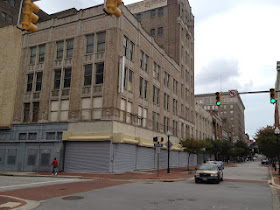 |
| Lexington Street 1942 |
Living in Baltimore one comes to believe that great walkable shopping streets with tons of people crowding the sidewalks and glorious bright storefronts lining them have gone the way of the typewriter thanks to big box retail, malls and online shopping.
Until travels to San Francisco, New York, Chicago or even smaller peer cities like Pittsburgh prove otherwise: Hey, downtown shopping still exists, even in America! Even nearby DC's K Street feels like Paris compared to the mostly empty sidewalks of downtown Baltimore. What is going on?
The Downtown Partnership's just released its most recent Nielsen report (with 2014 numbers). It is very positive: More people live downtown old and young, more money is made downtown, more jobs more businesses, All, just not more retail.
 |
| Lexington Street 2015 |
The report also shows that the percentage of people living downtown (42,000 total in an area 1 mile around Pratt and Light Streets) and working in the City has even declined from 51% in 2009 to 48% in 2014. So much for the notion that more housing downtown would mean that people live where they work. Only 32% of all people who work downtown actually live in the City, that also slightly down from 34% in 2009.
With its 42,000 downtown residents Baltimore compares well with other cities, more residents than Boston, Denver and San Diego in 2011 for example, although as much housing as those cities build downtown, they may have caught up by now. A similar comparison of retail area between cities isn't readily available, but it is obvious that Baltimore is lagging compared to all the cities in the chart maybe with the exception of Charlotte.
It is hard to say where the Baltimore downtown retail scarcity comes from in a country that is "over-retailed" like no other in the world. Even the suburban shopping options out west (Westview Mall, Security Mall) or East (Eastpoint Mall) are troubled places, only Towson to the north and White Marsh far out to the northeast seem to be doing well. Baltimore's own mall, Mondawmin is grossing
 |
| Large Cities: Downtown population 2011 |
 |
| Fashion Show Harbor East |
Harbor East is the closest thing to a vibrant retail district and it may also be the answer why the traditional retail areas have such a hard time. Few cities have shifted their downtown to the extent Baltimore has done it. As a result of those transformations the Westside and the old financial district still need to find a new identity and brand when it comes to retail. They should take a lesson from Hampden's Avenue, Federal Hill's Light Street and Highlandtown's Eastern Avenue which have remarkable come-backs as neighborhood retail streets. Of course retail re-makes are also occurring from whole cloth with plenty of shopping in brand new large developments such as the Rotunda, Canton Crossing/Brewers Hill, and McHenry Row.
 |
| 400 East Pratt |
Small main-street type retail can be seen in the old Westside on Saratoga Street and on parts of West Baltimore Street. But none of this is really enough for a city of 600,000 residents which is the center of a vibrant and stioll growing metro area with 2.7 million.
Shops and an active street-life just have to be part of an authentic urban experience. For a city of neighborhoods, quirky and vibrant neighborhood shopping districts, are a valuable asset not to be underestimated but we still need a downtown with viable stores.
Klaus Philipsen, FAIA
Downtown Report 2016
BBJ article about the 2016 report
Nielsen Peer City Report 2011 for Seattle
Have you been to Harbor East stores or Canton Crossing stores on a weekend. Packed. Hard to switch this back to the cbd.
ReplyDeleteCertainly didn't suggest to switch retail back to the CBD.
Delete